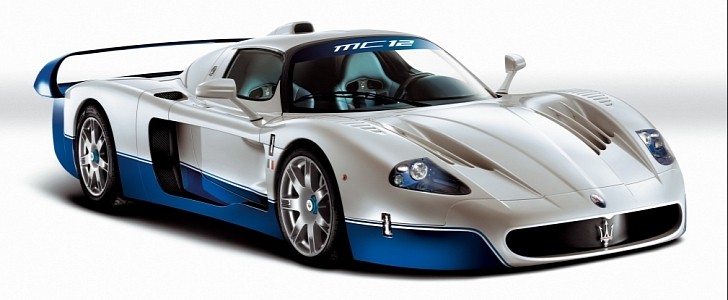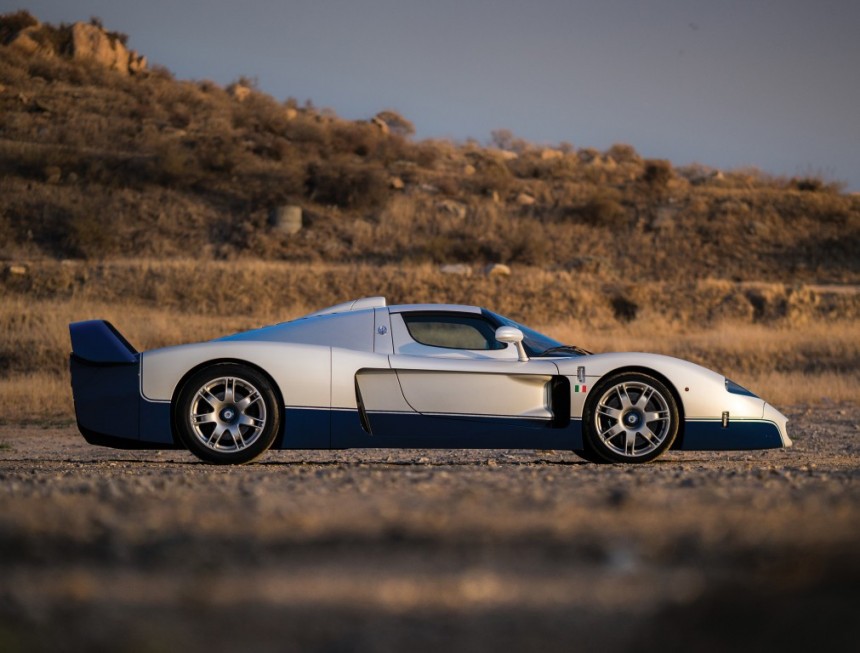The all-new MC20 is universally praised by automotive journalists for its poised handling, but Maserati’s return to the mid-engine arena wouldn’t have been possible without the long-tailed MC12 from 2004. Developed specifically to compete in the FIA GT Championship, the Maserati Corse 12-cylinder supercar was designed by the one and only Frank Stephenson.
Frank who? The guy who made a name for himself with the rear spoiler of the Ford Escort RS Cosworth. The designer’s next big hit came in the guise of the first-generation BMW X5, followed by the BMW-developed MINI.
Also credited for penning the Fiat 500 and almost every modern-day McLaren from the 12C to the almighty 720S, the 62-year-old designer also served as the director of Ferrari-Maserati Concept Design and Development between 2002 and 2006. It was during this era that Frank and his team came up with the glorious-sounding F430, the MC12, and the Enzo-based FXX.
Longer, wider, and slightly taller than the road-going Enzo, the MC12 shares only one exterior element with Ferrari’s limited-run model: the windshield. Derived from a Giorgetto Giugiaro concept refined by Stephenson, the V12-engined supercar numbers a grand total of 62 units: 50 road-legal cars and 12 track monsters derived from the FIA GT racing car.
Clearly rarer than the Ferrari on which it’s based, the MC12 is kind of curious in the sense that the first 25 road-going vehicles are longer than the other 25 units. Why, you ask? The Fédération Internationale de l'Automobile changed the GT Championship’s rules in the first full season of the racecar, reducing the maximum length allowed in the short-lived series. Alas, the MC12 had to be shortened by 150 millimeters (make that 5.9 inches).
Coincidentally, the wheelbase of the homologation special is 150 millimeters longer than that of the Enzo. Tipping the scales at 1,335 kilos (2,943 pounds), the MC12 is lighter than the Enzo but less powerful because Ferrari-owned Maserati wasn’t allowed to outperform the Prancing Horse of Maranello.
The 6.0-liter motor is good for 630 PS (621 horsepower) and 652 Nm (481 pound-feet) of torque, figures that are so and so by modern standards. Even the eighth-gen Corvette Z06 develops more ponies from a 5.5-liter V8, but lest we forget, the MC12 was launched in 2004, and the C8 Z06 is expected to enter production sometime in the summer for the 2023 model year.
Slightly stiffer than the Enzo due to its motorsport-infused DNA, the long-tailed Mazza features a flatter torque curve that matters a lot under hard acceleration. 100 kilometers per hour (62 miles per hour) takes just 3.6 seconds, and the MC12 tops 330 kilometers per hour (205 miles per hour).
Originally priced at €600,000, which is €806,525 adjusted for inflation or $925,000 at current exchange rates, the MC12 is rocking a carbon-fiber and Nomex tub with aluminum subframes up front and out back. Double wishbones on every corner, pushrod-type suspension, progressive-rate dampers, and coaxial springs also need to be mentioned, along with cast-iron brake discs instead of the Ferrari Enzo’s carbon-ceramic brake discs.
Equipped with 19-inch alloys with center-lock nuts finished in red for the driver’s side and blue for the passenger side, the MC12 was originally offered with Pirelli P Zero Corsa high-performance summer tires. The targa-topped road car features a longitudinally-mounted transmission, as in a paddle-shift automated manual with two shift modes: Sport and Race.
The spartan interior of the MC12 can only be described as a sea of carbon fiber and blue leather. The central portion of the carbon-fiber bucket seats is trimmed with a high-grip synthetic fabric marketed under the Brightex handle. As expected of a Maserati, an oval-shaped clock is also featured.
The story of the MC12 ends with the Birdcage 75th that celebrated the 75th anniversary of Pininfarina. Designer Ken Okuyama took inspiration from the 1970 Ferrari 512S Modulo for the MC12-based concept. As the name implies, the Birdcage 75th honors the Tipo 60/61 family of racing cars that feature an intricate tubular space frame made from around 200 steel tubes.
Also credited for penning the Fiat 500 and almost every modern-day McLaren from the 12C to the almighty 720S, the 62-year-old designer also served as the director of Ferrari-Maserati Concept Design and Development between 2002 and 2006. It was during this era that Frank and his team came up with the glorious-sounding F430, the MC12, and the Enzo-based FXX.
Longer, wider, and slightly taller than the road-going Enzo, the MC12 shares only one exterior element with Ferrari’s limited-run model: the windshield. Derived from a Giorgetto Giugiaro concept refined by Stephenson, the V12-engined supercar numbers a grand total of 62 units: 50 road-legal cars and 12 track monsters derived from the FIA GT racing car.
Clearly rarer than the Ferrari on which it’s based, the MC12 is kind of curious in the sense that the first 25 road-going vehicles are longer than the other 25 units. Why, you ask? The Fédération Internationale de l'Automobile changed the GT Championship’s rules in the first full season of the racecar, reducing the maximum length allowed in the short-lived series. Alas, the MC12 had to be shortened by 150 millimeters (make that 5.9 inches).
Coincidentally, the wheelbase of the homologation special is 150 millimeters longer than that of the Enzo. Tipping the scales at 1,335 kilos (2,943 pounds), the MC12 is lighter than the Enzo but less powerful because Ferrari-owned Maserati wasn’t allowed to outperform the Prancing Horse of Maranello.
Slightly stiffer than the Enzo due to its motorsport-infused DNA, the long-tailed Mazza features a flatter torque curve that matters a lot under hard acceleration. 100 kilometers per hour (62 miles per hour) takes just 3.6 seconds, and the MC12 tops 330 kilometers per hour (205 miles per hour).
Originally priced at €600,000, which is €806,525 adjusted for inflation or $925,000 at current exchange rates, the MC12 is rocking a carbon-fiber and Nomex tub with aluminum subframes up front and out back. Double wishbones on every corner, pushrod-type suspension, progressive-rate dampers, and coaxial springs also need to be mentioned, along with cast-iron brake discs instead of the Ferrari Enzo’s carbon-ceramic brake discs.
Equipped with 19-inch alloys with center-lock nuts finished in red for the driver’s side and blue for the passenger side, the MC12 was originally offered with Pirelli P Zero Corsa high-performance summer tires. The targa-topped road car features a longitudinally-mounted transmission, as in a paddle-shift automated manual with two shift modes: Sport and Race.
The spartan interior of the MC12 can only be described as a sea of carbon fiber and blue leather. The central portion of the carbon-fiber bucket seats is trimmed with a high-grip synthetic fabric marketed under the Brightex handle. As expected of a Maserati, an oval-shaped clock is also featured.
The story of the MC12 ends with the Birdcage 75th that celebrated the 75th anniversary of Pininfarina. Designer Ken Okuyama took inspiration from the 1970 Ferrari 512S Modulo for the MC12-based concept. As the name implies, the Birdcage 75th honors the Tipo 60/61 family of racing cars that feature an intricate tubular space frame made from around 200 steel tubes.

























